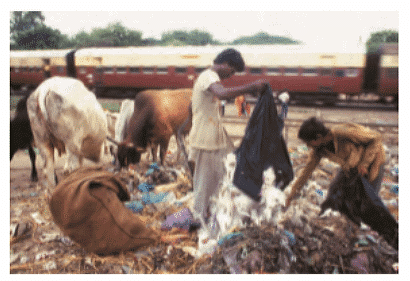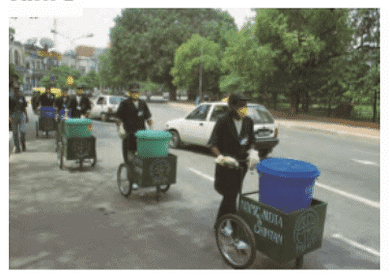NCERT Solutions for Class 6 Civics - Urban Administration
Q1. Why did the children go to Yasmin Khala’s house?
Ans: The kids aimed to fix the broken streetlight they had accidentally damaged. So, Rehana proposed they go to Yasmin Kala's place nearby to learn the steps for getting it repaired since she recently retired from the Municipal Corporation.
Q2. List four ways in which the work of the Municipal Corporation affects the life of a city-dweller.
Ans: Four ways in which the work of the Municipal Corporation affects the life of a city-dweller:
(i) Construction and maintenance of roads, parks, street lights etc.
(ii) Cleansing and maintenance of drainage system.
(iii) Collection and disposal of garbage.
(iv) Supply of safe drinking water.
(v) Electricity supply.
Q3. Who is a Municipal Councillor?
Ans: A Municipal Councillor is an elected member of the committee of Municipal Corporation.
- The ward or municipal councillor listened to the problems of the local people and helped them to contact the concerned authority.
- They also make a budget for their ward and put it in front of the whole council.
Q4. What did Gangabai do and why?
Ans: Gangabai expressed her dissatisfaction to the Ward councillor about the poor upkeep of the streets. The garbage was not being properly disposed of, leading to problems like an increase in stray dogs, rats, flies, and mosquitoes in the area.
Q5. How does the Municipal Corporation earn the money to do its work?
Ans: Municipal Corporation earns money from taxes collected from various sources like property taxes, water taxes, entertainment taxes, and taxes on education and other amenities.
Q6. Discuss
In the two photographs, you see different ways of collecting and disposing of garbage.
 Photo 1
Photo 1 Photo 2(i) Which way do you think provides safety to the person disposing of garbage?
Photo 2(i) Which way do you think provides safety to the person disposing of garbage?
(ii) What are the dangers of collecting garbage in the manner shown in the first photograph?
(iii) Why do you think that proper ways of disposing of garbage are not available to those who work in municipalities?
Ans:
(i) I think Photo 2 provides safety to the person disposing of garbage.
(ii) In the first photograph, people collecting garbage might get injured or infected and may fall ill. It will affect their health as they are not taking any safety measures. The garbage will also not be collected properly.
(iii) The proper ways of disposing of garbage are not available to those who work in municipalities, possibly due to the lack of funds or the careless behaviour of the officials and workers.
Q7. Several poor people in the city work as domestic servants as well as work for the Corporation, keeping the city clean. Yet the slums in which they live are quite filthy. This is because these slums seldom have any water and sanitation facilities. The reason often given by the Municipal Corporation is that the land in which the poor have set up their homes does not belong to them and that slum-dwellers do not pay taxes. However, people living in middle-class neighborhoods pay very little in taxes compared to the amount of money the corporation spends on setting up parks, street lighting facilities, regular garbage collection, etc. Also as you read in this chapter, the property taxes collected by the Municipality make up only 25-30 percent of its money. Why do you think it is important that the Corporation should spend more money on slum localities? Why is it important that the Municipal Corporation provide the poor in the city with the same facilities that the rich get?
Ans: It is important that the Corporation should spend more money on slum localities because:
(i) If they do not provide them equal facilities, then it is discrimination based on economic conditions.
(ii) Slums are also a part of the society. The people living there contribute a lot to society and also the major work population, such as domestic servants, municipal workers, cleaners, etc.
(iii) Diseases can also spread to the neighbouring locality of the slums due to dirty conditions.
Ques 8. Look at the image below.
The Government of India launched the Swachh Bharat Mission on 2 October 2014 to promote cleanliness in both rural and urban areas all over the nation. Under the “Swachh Bharat, Swachh Vidyalaya” campaign, many activities are also being carried out in schools to generate awareness of sanitation and hygiene among students. Observe the ways in which “Swachh Bharat Abhiyan” is being implemented by the municipality/panchayat in your locality. Prepare a poster and display it in your school.
Ans: This is an activity that students need to carry out at their school.
|
69 videos|386 docs|80 tests
|
FAQs on NCERT Solutions for Class 6 Civics - Urban Administration
| 1. शहरी प्रशासन क्या है? |  |
| 2. शहरी स्थानीय निकायों के प्रकार कौन-कौन से होते हैं? |  |
| 3. शहरी प्रशासन में जन भागीदारी का क्या महत्व है? |  |
| 4. शहरी प्रशासन में कौन-कौन सी सेवाएं प्रदान की जाती हैं? |  |
| 5. शहरी प्रशासन का विकास कैसे होता है? |  |























